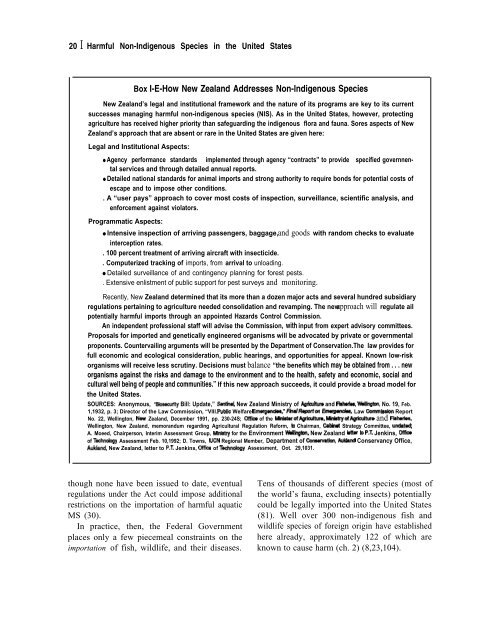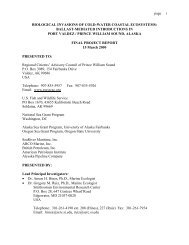Harmful Non-Indigenous Species in the United States - Aquatic ...
Harmful Non-Indigenous Species in the United States - Aquatic ...
Harmful Non-Indigenous Species in the United States - Aquatic ...
You also want an ePaper? Increase the reach of your titles
YUMPU automatically turns print PDFs into web optimized ePapers that Google loves.
20 I <strong>Harmful</strong> <strong>Non</strong>-<strong>Indigenous</strong> <strong>Species</strong> <strong>in</strong> <strong>the</strong> <strong>United</strong> <strong>States</strong>Box I-E-How New Zealand Addresses <strong>Non</strong>-lndigenous <strong>Species</strong>New Zealand’s Iegal and <strong>in</strong>stitutional framework and <strong>the</strong> nature of its programs are key to its currentsuccesses manag<strong>in</strong>g harmful non-<strong>in</strong>digenous species (NIS). As <strong>in</strong> <strong>the</strong> <strong>United</strong> <strong>States</strong>, however, protect<strong>in</strong>gagriculture has received higher priority than safeguard<strong>in</strong>g <strong>the</strong> <strong>in</strong>digenous flora and fauna. Sores aspects of NewZealand’s approach that are absent or rare <strong>in</strong> <strong>the</strong> <strong>United</strong> <strong>States</strong> are given here:Legal and Institutional Aspects:● Agency performance standards implemented through agency “contracts” to provide specified governnentalservices and through detailed annual reports.● Detailed national standards for animal imports and strong authority to require bonds for potential costs ofescape and to impose o<strong>the</strong>r conditions.. A “user pays” approach to cover most costs of <strong>in</strong>spection, surveillance, scientific analysis, andenforcement aga<strong>in</strong>st violators.Programmatic Aspects:● Intensive <strong>in</strong>spection of arriv<strong>in</strong>g passengers, baggage, and goods with random checks to evaluate<strong>in</strong>terception rates.. 100 percent treatment of arriv<strong>in</strong>g aircraft with <strong>in</strong>secticide.. Computerized track<strong>in</strong>g of imports, from arrival to unload<strong>in</strong>g.● Detailed surveillance of and cont<strong>in</strong>gency plann<strong>in</strong>g for forest pests.. Extensive enlistment of public support for pest surveys and monitor<strong>in</strong>g.Recently, New Zealand determ<strong>in</strong>ed that its more than a dozen major acts and several hundred subsidiaryregulations perta<strong>in</strong><strong>in</strong>g to agriculture needed consolidation and revamp<strong>in</strong>g. The new approach will regulate ailpotentially harmful imports through an appo<strong>in</strong>ted Hazards Control Commission.An <strong>in</strong>dependent professional staff will advise <strong>the</strong> Commission, with <strong>in</strong>put from expert advisory committees.Proposals for imported and genetically eng<strong>in</strong>eered organisms will be advocated by private or governmentalproponents. Countervail<strong>in</strong>g arguments will be presented by <strong>the</strong> Department of Conservation.The Iaw provides forfull economic and ecological consideration, public hear<strong>in</strong>gs, and opportunities for appeal. Known low-riskorganisms will receive less scrut<strong>in</strong>y. Decisions must balance “<strong>the</strong> benefits which may be obta<strong>in</strong>ed from . . . neworganisms aga<strong>in</strong>st <strong>the</strong> risks and damage to <strong>the</strong> environment and to <strong>the</strong> health, safety and economic, social andcultural well be<strong>in</strong>g of people and communities.” If this new approach succeeds, it could provide a broad model for<strong>the</strong> <strong>United</strong> <strong>States</strong>.SOURCES: Anonymous, “Biosecutity Bill: Update,” SantlneJ, New Zealand M<strong>in</strong>istry of Agrloulture and Flshedes, VWngton, No. 19, Feb.1,1932, p. 3; Director of <strong>the</strong> Law Commission, “VIII. Pubtic Welfare Emergenofes,” l%all?qortm Ehww?&M, Law Wnndedon ReportNo. 22, Well<strong>in</strong>gton, New Zealand, December 1991, pp. 230-24S; OffIoe of <strong>the</strong> MlnisterofAgrloulture, MkdstryofAgrioutture and Ftsheries,Well<strong>in</strong>gton, New Zealand, memorandum regard<strong>in</strong>g Agricultural Regulation Reform, to Chairman, Cab&ret Strategy Committee, undate@A. Moeed, Chairperson, Interim Assessment Group, M<strong>in</strong>btry for <strong>the</strong> Environment Wdkgton, New Zealand letter to P.T Jenk<strong>in</strong>s, Offioeof TArwlogy Assessment Feb. 10,1992; D. Towns, IUCN Regional Member, Department of Oonservatkm, Auldand Conservancy Office,Aukland, New Zealand, letter to P.T. Jenk<strong>in</strong>s, Office of Tt<strong>in</strong>ology Assessment, Oot. 29,1031.though none have been issued to date, eventual Tens of thousands of different species (most ofregulations under <strong>the</strong> Act could impose additional <strong>the</strong> world’s fauna, exclud<strong>in</strong>g <strong>in</strong>sects) potentiallyrestrictions on <strong>the</strong> importation of harmful aquatic could be legally imported <strong>in</strong>to <strong>the</strong> <strong>United</strong> <strong>States</strong>MS (30).(81). Well over 300 non-<strong>in</strong>digenous fish andIn practice, <strong>the</strong>n, <strong>the</strong> Federal Government wildlife species of foreign orig<strong>in</strong> have establishedplaces only a few piecemeal constra<strong>in</strong>ts on <strong>the</strong> here already, approximately 122 of which areimportation of fish, wildlife, and <strong>the</strong>ir diseases. known to cause harm (ch. 2) (8,23,104).














